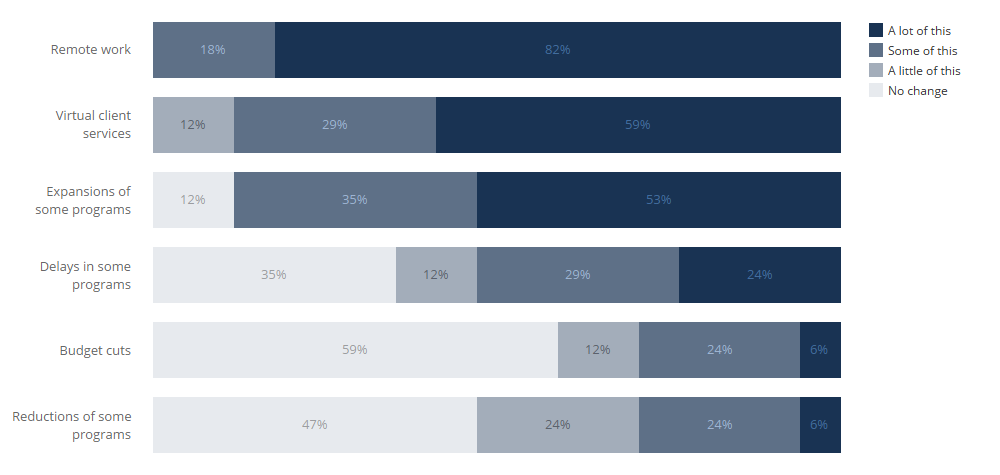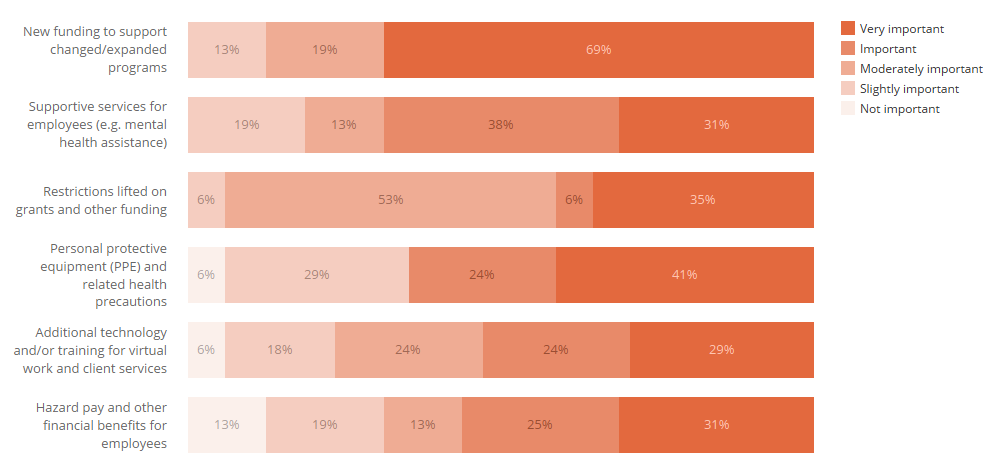04 Findings
Mission, Programs, and Workflows
As we emerge from the pandemic, the concerns housing providers have about needs and programs have declined, but are still significant.
When assessing the disruption caused by the pandemic, housing providers in Richmond have become more positive over the past year. Last summer, almost 60% said that COVID-19’s impact was either somewhat or very disruptive. That has now dropped to about 40%. The percent that said that the pandemic had no or little disruption has increased from 18% to 30%. While this reflects some move back to “normalcy,” it’s clear that one year later, impacts remain a very significant concern for many housing organizations
FIGURE NUMBER 4.1
Level of disruption to core services

With regard to the ability to meet housing needs, prior to the pandemic almost 80% felt that they were able to fully or significantly meet client needs. That dropped to 45% as the pandemic raged last summer. When looking ahead to post pandemic operations, only 60% see the ability to fully or significantly meet housing needs, indicating longer term shifts between the needs in the community and the capacity of providers.
FIGURE NUMBER 4.2
Rated ability to meet needs in before, during, and after pandemic

There’s no question about the shifts that housing providers made in their programming as a result of COVID-19. Despite early high levels of concern about reduced or terminated service delivery, over 70% of nonprofit leaders indicated they had developed and implemented new and/or specialized initiatives to meet changing needs during the pandemic. Only one in five had made no changes to the services that they provide.
FIGURE NUMBER 4.3
Extent of operational changes made in response to COVID-19

FIGURE NUMBER 4.4
Level of concern about reduced or terminated service delivery

When it comes to what they need to continue to overcome and mitigate the impact of the pandemic, it is no surprise that 90% of respondents replied that “new funding” for expanded services and different programs targeted to shifting needs is very important or important. Other needs that ranked high included:
- 70% – Support services for employees (i.e., mental health)
- 65% – Continued access to PPE
- 53% – Technology and training to support virtual work for staff and clients
- 40% – Lifting of traditional restrictions on grants that impeded flexibility
FIGURE NUMBER 4.5
Importance of selected needs for mitigating pandemic’s impact

Addressing the needs of homeless persons remains the most complex and profound impact of COVID.
COVID-19 disrupted the traditional service approach to emergency shelter. Traditional shelter bed capacity was reduced due to varying shelter safety protocols and shifted to a non-congregant model. The massive effort to successfully house homeless persons in motels and hotels on a temporary basis had its own set of consequences. As the risk of transmission declines due to vaccination and improved mitigation techniques, traditional shelters are coming back to full capacity, though some clients continue to prefer motels which offers greater privacy and independence.
There has also been a substantial increase in assistance for homelessness through the pandemic from both public and private sources; however, providers see that flow of funds inevitably declining over the next year. Some “safety net” shelter services will end in April with uncertainty about the ability of other programs to provide replacement assistance.
At the same time that concerns about long term funding are high, providers see the underlying conditions that contribute to homelessness becoming more acute. This includes the strong Richmond housing market that is pushing housing prices higher and resulting in more displacement as neighborhoods gentrify.
COVID-19 has contributed to a spike in demand for emergency housing and services. An example of this has been the spike in drug overdoses in the area. Drug deaths in Virginia set a record in 2020 and 2021 is projected to increase. Job losses have been worst in the lowest paying jobs—the same that have also been the slowest to recover. While emergency assistance and expanded unemployment benefits have helped many, those who are affected by mental illness, drug dependence, and alcoholism have been more challenged to access these resources.
Rehabilitation, repair and weatherization programs were almost halted early, but have made a comeback—with some modifications.
Many clients continue to have concerns about program staff entering their homes to address substandard conditions. As a result, there continues to be more focus on the exterior of the home. This means that some health and safety items are less likely to be addressed. Weatherization of apartment communities have been slowed substantially, as most of these properties still are enforcing COVID-19 restrictions that make interior work high risk or impossible. Apartment owners have concerns about liability.
Many repair programs, including those that focus on improving accessibility, have traditionally relied on a large cohort of volunteers. Most volunteer programs were shut down early in the pandemic and have not yet returned. Companies that include employee volunteerism as a part of their charitable efforts have not yet relaxed the COVID-19 protocols that would permit these efforts to begin again.
Another significant sector within volunteerism is retired workers. This age group has been the most at risk from COVID-19 and has been the most cautious in terms of behavior. With vaccinations in this group at a high level, there may be some gradual return of this workforce later in the year.
Homeownership programs face cost increases and other pandemic-induced barriers to homebuyer readiness.
Home construction and apartment development have been the activities least affected by COVID-19, as contractors quickly adjusted to new procedures that allowed their work to continue. Consequently, the pace of construction was not significantly affected. What has affected these activities is the significant cost increase in building materials—especially lumber and wood products. Lumber has increased in cost by 170% over the past year. The supply chain for certain items has also been affected. For example, the wait time for kitchen appliances has been lengthy and has resulted in delays in home completion—resulting in higher interest carry costs.
Furthermore, some homebuilding programs that relied on a substantial volunteer component have been forced to shift to using more subcontractors, with a corresponding increase in the home cost. Overall, the cost of an affordable home has risen by approximately $15,000.
These trends have caused some providers to rethink the product they are providing. Several are considering options to reduce home size and increase energy efficiency in an effort to cut both initial and operating costs. One nonprofit has ventured into the arena of manufactured housing and has negotiated a 900 square-foot home with a price tag well below $100,000. This model is designed for placement in a park, but could also be used in non-park settings where zoning permits.
For prospective homebuyers, this higher price has been only one of several new barriers. Providers are also concerned that lower-income buyers have been less able to access homebuyer education, counseling, and credit repair as those services shifted to a virtual environment. Access to reliable high speed internet has become much more important for households hoping to achieve homeownership.
For existing homeowners, there is concern that financial challenges may come later in 2021 as forbearance programs begin to end and as homeowners exhaust their savings and reserves. Because the vast majority of emergency assistance is targeted to renters, some providers worry that homeowners may face challenges without access to assistance. Several providers are also looking at the importance of adding “aging in place” strategies for homeowners.
For renters, the picture is different. There is a national eviction moratorium still in place and billions of dollars in rental assistance flowing through state and local governments. The concern that several providers expressed was, given the unprecedented scale of assistance to renters to prevent eviction, would there be sufficient capacity to push the funding out? The sheer volume of applications, paperwork, and person-hours needed to deploy those funds in a timely manner could push some providers past their limits.
Rental housing development flourishes, though cost increases and provision of services are challenging.
Increased awareness of rental housing needs has helped to support continued production. Public and private resources to support the development of new affordable rental housing have been increasing. Several jurisdictions have made new commitments to rental production. In the long-term, COVID-19 has not impacted construction, but increases in materials are a threat to the financial viability of construction projects.
Property management has faced COVID challenges as a result of new protocols that reduce face to face interactions. One provider instituted online leasing and online rent payments. The system will require continuing efforts—especially for seniors who face greater challenges with virtual interactions. When fully implemented, such systems will provide greater operational efficiency. Service provision to vulnerable residents remains a challenge—both for residents and for staff.
Fears of significant shortfalls in rent collections have, for the most part, not materialized in affordable rental communities—especially in senior communities where COVID-19 did not affect the financial status of seniors on fixed incomes. One provider reported that collections were only off 3% from the previous year. The massive commitment of federal dollars to emergency rental assistance and eviction prevention may likely be used in privately-owned market-affordable apartments, rather than in assisted housing owned and managed by nonprofit providers.